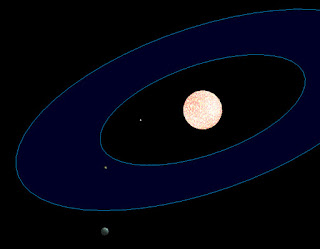 |
| Protoplanetary accretion disk around a new star |
Habitable Zones appear to be more stable and longer lasting around small stars, such as Red Dwarfs.[001] However, what are the chances of habitable planets appearing in these small zones around these small stars? It turns out that the chances may not be good.
According to the study A Decreased Probability Of Habitable Planet Formation Around Low-Mass Stars, multiple simulations suggest that low-mass stars are unlikely to have terrestrial planets of sufficient size within their Habitable Zones. This is due to a several factors. That's not to say it is impossible nor improbable; just not as common as previous thought.[002]
Other factors
Besides Habitable Zones, another factor to consider is the Habitable Planet Mass Limit. There is evidence that suggests that plate tectonic activity on a global level is a necessary factor for supporting life on a planet similar to Earth. Planets must be of a particular size in order to allow for global tectonics.[002] The lack or presence of global tectonics seems to be a factor in the differences between Venus and Earth. Though Venus seems to be large enough, its surface heals too quickly to allow for global tectonics.[003] The examples within our own solar system suggest that even when planets are large enough, there is no guarantee they will have global tectonics.Another factor is the Protoplanetary Disk. During the planet formation phase (accretion), there has to be enough material within the disk of matter that forms around very young stars (Protoplanetary Disk) in order produce larger planets. Though there are a lot of unknowns regarding this factor, the "ratio of disk mass to stellar mass is roughly constant with stellar mass". Also, planets seem to form much faster around small stars for various reasons. With less time to form and less mass within the Protoplanetary Disk, planets around low-mass stars may typically be much smaller. A second issue with fast forming planets is that they are much less likely to have enough time to collect enough water to support life.[002]
Exceptions?
Nothing is absolute. Gliese 581 is a Red Dwarf that has a number of large planets, and also has a debris disk that appears to have tens times amount of comet debris than our own Solar System. This suggests low-mass stars can have habitable planets. That said, Gliese 581 may be an outlier. Other factors are obviously involved that need further study.Primary reference:
S. N. Raymond, J. Scalo and V. S. Meadows, The Astrophysical Journal 669 (Nov., 2007) 606–614, arXiv:0707.1711 [astro-ph], A Decreased Probability of Habitable Planet Formation around Low-Mass Stars
Response:
Hacker News
Article Series:
- Limited lifespan of Habitable Zones around other stars [and a loosely held secret finally revealed about me]
- Small stars may have stable Habitable Zones, but habitable planets might not be common there
- Habitable Planets around White Dwarfs
- Habitable Worlds Around Binary Star Systems might not match Sci-fi
- How many Earth-like planets are orbiting Sun-like stars?
- First round of life in the Universe might have been possible extremely early
- Factors a planet needs for suitability of life; perhaps
- "Goldilocks zone of metallicity" on a galactic scale
- Maybe we are the first







